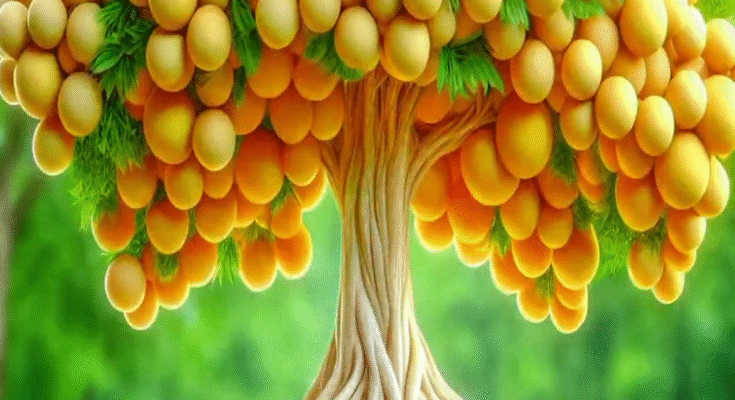Easy and Fast Method for Growing and Planting Longan Fruit Trees Using Stem Grafts
Longan (Dimocarpus longan), also known as “dragon’s eye,” is a popular tropical fruit in Southeast Asia. It is prized for its sweet, juicy flesh and aromatic flavor. While growing longan trees from seeds is possible, it is often slow and unpredictable, with seedlings taking many years to bear fruit and not always producing high-quality fruit. To overcome these issues, using stem grafting is a much faster and more reliable propagation method. This technique ensures quicker fruiting, better tree quality, and the ability to clone a desired longan variety.
In this guide, we will explore an easy and fast method for growing and planting longan fruit trees using stem grafts, making it ideal for home gardeners, hobbyists, and small-scale farmers.
Why Use Stem Grafting for Longan Trees?
Stem grafting involves joining a scion (a branch from a fruit-bearing tree) to a rootstock (a young seedling grown from seed). This method has many advantages:
- Faster fruit production: Grafted trees can begin bearing fruit in as little as 2–3 years.
- True-to-type fruit: Grafted trees are genetically identical to the parent tree, preserving flavor, size, and yield.
- Stronger growth: Combining the strong roots of a healthy seedling with a superior fruiting scion gives better growth and resistance.
Materials You Will Need
Before you start grafting, gather the following materials:
- Longan rootstock seedlings (6 months to 1 year old)
- Healthy scion wood from a mature, fruiting longan tree
- A sharp grafting knife or blade
- Grafting tape or plastic wrap
- Pruning shears
- Clean cloth or tissue
- Rooting hormone (optional)
- Small pots or planting bags with rich, well-drained soil
- Watering can
Step-by-Step: How to Graft Longan Trees Using the Stem Graft Method
Step 1: Select a Strong Rootstock
Choose healthy young longan seedlings grown from seeds. These should be about 6 to 12 months old, with a stem thickness close to a pencil. Make sure the rootstock is disease-free and actively growing.
Step 2: Collect the Scion
The scion should be taken from a mature longan tree known for high fruit yield and quality. Select a branch that is semi-hardwood (not too soft, not too woody), about the same thickness as the rootstock stem. Cut it early in the morning when the tree is most hydrated. Each scion should have 2–3 healthy buds.
Step 3: Make the Graft Cut
There are several grafting techniques, but the cleft graft is one of the easiest and most effective for longan:
- Cut the top of the rootstock straight across.
- Make a vertical cut (about 2–3 cm deep) down the center of the stem.
- Take the scion and trim its base into a wedge shape.
- Insert the wedge into the slit of the rootstock, ensuring the cambium layers (just beneath the bark) of both parts align as closely as possible.
Step 4: Secure the Graft
Wrap the graft union tightly with grafting tape, rubber strips, or plastic wrap to hold it in place and prevent moisture loss. Make sure no air gaps are present. Some gardeners also wrap the entire scion in clear plastic to maintain humidity during healing.
Step 5: Keep the Plant in Shade
Place the grafted plant in a shaded area away from direct sunlight and heavy rain. This allows the graft to heal and prevents dehydration. Keep the soil moist but not soggy.
Aftercare and Transplanting
Monitor the Graft
Within 2–4 weeks, if the graft is successful, you will notice the buds on the scion starting to swell and grow. Once new leaves begin to develop, you can gradually remove the plastic wrap.
Remove Rootstock Shoots
As the grafted scion grows, remove any shoots or suckers growing from below the graft point on the rootstock. These shoots can sap energy away from the grafted scion.
Transplanting into the Ground
After 3–4 months, or when the grafted tree is strong and healthy, you can transplant it into its permanent location. Choose a spot with full sunlight, well-drained soil, and good air circulation. Dig a hole twice the size of the root ball, add organic compost, and plant the tree at the same depth it was in the pot.
Tips for Success
- Perform grafting in the early morning or late afternoon when temperatures are cooler.
- Clean all tools before grafting to prevent disease.
- If using multiple scions, label them to track the success of different varieties.
- Apply a natural mulch around the base of the plant to retain moisture and suppress weeds.
- Fertilize lightly after new growth appears, using a balanced organic fertilizer.
Benefits of This Method
This easy and fast stem grafting method for longan propagation offers many benefits:
- You skip the long waiting period of seed-grown trees.
- You ensure high-quality fruit.
- It allows you to grow multiple trees from a single parent tree.
- It works well in small spaces and controlled conditions, even for balcony or container gardeners.
Conclusion
Growing and planting longan fruit trees using stem grafts is a practical, efficient, and rewarding method for anyone who wants to enjoy this delicious fruit faster. With just a few simple tools, careful technique, and a little patience, you can grow vigorous, fruit-bearing longan trees that thrive in your garden or orchard. Whether you’re a beginner or experienced gardener, grafting longan trees gives you the best chance of success with less time and greater yield.



